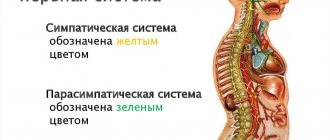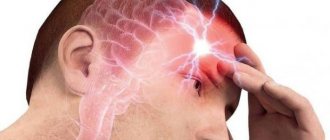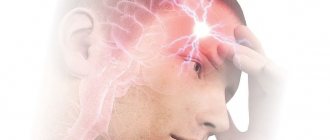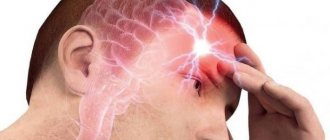Doctors Cost
Price list Doctors clinic
Vegetovascular dystonia (VSD) is now called by doctors somatoform dysfunction of the autonomic nervous system. This is a common disease that affects women 2 times more often than men. VSD is just a syndrome, but it must be taken into account when prescribing treatment for the underlying disease. To talk about pathology, let’s remember how the human nervous system works.
Table 1. Human nervous system - simplified diagram
| Nervous system. | Somatic. Responsible for the work of skeletal muscles. A person can control it. | |
| Vegetative. Responsible for the functioning of internal organs. Does not submit to willpower. | Sympathetic. Strengthens the activity of the heart, constricts blood vessels, increases blood pressure. | |
| Parasympathetic. Relaxes heart rate, dilates blood vessels, reduces blood pressure. | ||
The autonomic nervous system has a central and peripheral division. Its representations are in the cerebral cortex, brainstem, hypothalamus, and spinal cord. The peripheral section is represented by ganglia and nerve plexuses. If there are disturbances in any of these departments, symptoms of VSD appear.
Causes
Vegetative-vascular dystonia in most cases is a secondary pathology that complicates existing somatic and neurological diseases, but requires mandatory treatment. There are causative and provoking factors for its development.
Table 2. Types and causes of VSD
| Factors | Kinds | Examples |
| Callers. | Psychogenic. | Stress. Neurosis. Depression. |
| Infectious. | Chronical bronchitis. Sluggish pyelonephritis. Encephalitis. | |
| Dishormonal. | Pregnancy. Climax. Puberty. | |
| Physical. | Radiation. Vibration. Overwork. | |
| Chemical. | Alcohol. Nicotine. Some medications. | |
| Brain lesions. | Encephalopathy. Consequences of TBI. Parkinson's disease. | |
| Somatic pathology. | Thyrotoxicosis. Diabetes. Hypertonic disease. | |
| Provoking. | Personality characteristics. | Psychovegetative reactions. |
| Constitutional predisposition. | Typical manifestations of VSD. | |
| Socio-economic prerequisites. | Low standard of living. Poor nutrition. Ultraviolet radiation deficiency. | |
| Perinatal factors. | Infections. Hypoxia. Rhesus conflict. |
Vegetative-vascular dystonia occurs as a result of a psycho-emotional reaction, its symptoms are superimposed on existing autonomic abnormalities of the human body, treatment must take this fact into account.
Indications for treatment
The main indication is a clinically confirmed diagnosis of vegetative-vascular dystonia. Since VSD is a syndrome, the indications for its therapy correspond to disorders of various etiologies: vascular, psychological, neurological, cardiological and many others.
If your professional responsibilities involve high mental and emotional stress, stressful situations, overwork, or if you have a hereditary predisposition to VSD, sign up for a consultation with a specialist. Timely prevention will help avoid worsening problems, because the disease is easier to prevent than to treat.
Manifestations
VSD is characterized by many different manifestations. Almost all body systems are affected.
- Cardiovascular. Heart rate and blood pressure change, cardiac-type pain and changes in the ECG are noted.
- Pulmonary. There is a feeling of lack of air, inhalation is impaired, blood oxygen saturation deteriorates, and paresthesia appears.
- Nervous. Worrying headaches, tinnitus, weakness, dizziness, fainting. Thinking slows down. I am tormented by fluctuations in body temperature, hyperkinesis, and episodes of depressive mood.
Table 3. Action of the sympathetic and parasympathetic systems
| Sympathetic | Parasympathetic | |
| Pupil | Extension | Narrowing |
| Salivation | Insufficient | Excessive |
| Pulse | Increased frequency | Reduction |
| Arterial pressure | Promotion | Demotion |
| Bronchial lumen | Extension | Narrowing |
| Gastric juice | Decreased secretion | Increased secretion |
| Intestinal peristalsis | Reduced | Reinforced |
| Leather | Pale | Blushed |
| Sweating | Decreased | Increased |
Vascular dystonia. Symptoms and treatment
- Sympathicotonia is the predominance of the tone of the sympathetic nervous system. It is characterized by: pale skin, vasoconstriction, hypertension, tachycardia, dilated pupils, intestinal lethargy, heightened anxiety, and a feeling of fear.
- Vagotonia is the reverse state of sympathicotonia. Accompanied by redness of the skin, dilation of blood vessels, sweating, hypotension, bradycardia, constriction of the pupils, acceleration of bowel function, and irritability.
Sometimes the symptoms of VSD are mosaic; in this case, sympathetic and parasympathetic disorders are present simultaneously.
Therapy is selected individually, taking into account the main manifestations and the predominance of one or another department.
Eltacin® in the treatment of VSD
Therapy for VSD should be aimed at eliminating its cause, and not masking the symptoms. This is precisely why Eltacin® was developed. It contains 3 amino acids: cystine, glycine and glutamic acid. Their combination promotes the production of glutathione in the body - one of the powerful and natural antioxidants in the body, which neutralizes the effects of free radicals, prolongs the life of cells and prevents their death, normalizes the supply of oxygen to tissues and individual cells and helps enzymes maintain their functions. Thanks to this, the drug allows you to eliminate the symptoms of VSD, as well as influence the root of the problem and restore the balance between organs and systems, disturbed by the negative effects of free radicals.
Eltacin®:
- is the strongest endogenous antioxidant;
- sold at an affordable price.
- dispensed without a doctor's prescription;
Vegetovascular dystonia. Symptoms
Sleep disturbance.
The most common problem for people suffering from a disorder of the autonomic nervous system. There are two extremes: increased drowsiness, when you constantly want to sleep, and insomnia due to disruption of biorhythms. In both cases, sleep is superficial and it is rare to get a good night's sleep. Conventional treatment has no effect.
Instability of the psycho-emotional sphere.
As a result of insomnia, the ability to concentrate is impaired and memory decreases. A person cannot do his job efficiently. Nervous breakdowns and mood swings occur. Periods of unbridled fun are replaced by apathy, depression, and sometimes directed aggression.
Dermographism.
If you run your fingernail over the patient’s skin, a white stripe will appear in sympathotonics, and a red stripe in vagotonics. This is due to the reaction of blood vessels. In the first case they narrow, in the second they expand. This is exactly how the skin reacts to stress and sports. These features must be taken into account when engaging in physical education and sports.
Breathing disorders
appear with parasympathetic VSD. As the load on the bronchi increases, shortness of breath develops. Triggering factors include stress, physical activity, and ARVI. The well-being of patients worsens over the years, shortness of breath gives way to attacks of suffocation. Some patients develop bronchial asthma.
Meteosensitivity.
The human body reacts extremely violently to changes in atmospheric pressure, windy or rainy weather. Weakness appears, severe headaches sometimes put you to bed, and a complete lack of performance.
Digestive problems
with VSD, the symptoms are varied and opposite: increased and decreased appetite, diarrhea and constipation, abdominal pain, nausea, food selectivity. Treatment by a gastroenterologist helps little.
Disorders of the genitourinary system.
Increased or decreased urination, pain in the perineum, lower abdomen in the absence of pathology, menstrual irregularities, libido, erectile dysfunction.
Headache and dizziness
caused by impaired cerebral vascular tone. They are provoked by mental and emotional overload and stress. Sometimes fainting, tinnitus, and nausea may occur.
Table 4. Severity of VSD
| Degree | Manifestations |
| Easy. | Functionality has been preserved. The discomfort is minimal and occurs periodically. |
| Average. | Periodically, the ability to work is lost due to the occurrence of vegetative crises. |
| Heavy. | Inability to work due to persistent and long-term vegetative disorders, frequent crisis conditions. |
Diagnostic methods
Vegetative-vascular dystonia is an exception diagnosis. This means that it is placed after a complete examination of the cardiovascular and nervous systems, if no abnormalities are found in them.
For diagnosis, you need to contact a general practitioner, who, if necessary, will refer you to a cardiologist, neurologist or endocrinologist. In order for a doctor to make an accurate diagnosis, it is necessary to accurately describe the symptoms and the time of their onset. The therapist will definitely clarify whether the patient drinks alcohol, nicotine, how often he drinks coffee and what daily routine he follows. This data is necessary to correctly make recommendations for the treatment of the disease.
To diagnose vegetative-vascular dystonia, the following methods are used:
- laboratory diagnostics - general blood and urine analysis without specific changes, in biochemical analysis the lipid ratio may be disturbed;
- blood test for hormones - a study of thyroid hormones is indicative; if they increase, tachycardia and weight loss may be observed;
- ECG - changes are not typical for VSD, sometimes it is possible to record tachycardia, single extrasystoles, but there are no signs of severe conduction disturbances in the heart;
- EEG - electroencephalogram can reveal slight deviations in the conduction of impulses in the brain;
- Ultrasound of internal organs - examination of the abdominal cavity in case of complaints of indigestion, examination of the heart, kidneys, and pelvic organs in women.
Dysfunction of the nervous system is not accompanied by damage to internal organs; most indicators are within the normal range, despite complaints of poor health.
Crises with vascular dystonia. Symptoms and treatment in adults
Panic attack
– sympathoadrenal crisis. A huge amount of adrenaline is released into the blood. A sharp headache occurs, blood pressure rises, the heart “jumps out of the chest,” the skin turns pale. Fingers and toes become cold and numb. A person feels a strong feeling of anxiety and fear. The crisis passes on its own. After it, the patient feels exhausted for a long time.
Vagoinsular crisis
occurs when insulin is released into the blood. As a result, glucose levels drop sharply and heart failure occurs. It seems to stop. The patient feels short of breath. The pulse slows down, the pressure drops, and the vision becomes dark. Fainting may develop. The skin turns red and there is increased sweating. There may be diarrhea and flatulence.
Complications
Vegetative-vascular dystonia sometimes leads to the most dangerous exacerbations and complications. The development of vegetative crises is possible, observed in half of the cases. Depending on the part of the autonomic system that is affected, crises can be vagoinsular, sympathoadrenal, or mixed.
A sympathoadrenal crisis is called a panic attack. This condition is accompanied by a sharp release of adrenaline in the blood. The abnormal process occurs under the influence of the autonomic system. As the disorder develops, the patient experiences a sharp headache and increased heart rate. Symptoms of cardialgia may appear. The face turns red or pale.
Vegetative-vascular dystonia is accompanied by the appearance of symptoms of arterial hypertension, increased heart rate, increased temperature to subfebrile levels, chills, loss of sensation in the limbs, a feeling of severe anxiety and fear, which is taken into account in the diagnosis. The crisis ends as suddenly as it begins and lasts for a short period. After its completion, asthenia develops, polyuria occurs, accompanied by the release of urine of low specific gravity.
Vagoinsular crisis is characterized by criteria opposite to sympathetic effects. In this state, there is a release of insulin in the blood, the glucose level drops sharply, and the activity of the digestive organs increases.
A person’s heart stops, arrhythmia develops, dizziness develops, breathing becomes impaired, a feeling of lack of air appears, the pulse slows down, and blood pressure drops. Symptoms of increased sweating, redness of the skin, general weakness, and darkening of the eyes appear.
The crisis is characterized by increased intestinal motility, causing flatulence, diarrhea, and rumbling in the abdomen. After the end of the attack, pronounced post-crisis asthenia is observed. In most cases, mixed types of crises appear, both parts of the autonomic system are activated.
Vegetative-vascular dystonia. Treatment
A neurologist selects a treatment regimen based on complaints, gender, age, examination and diagnostic results. No two people with VSD are treated exactly the same. Therefore, you should not self-medicate.
Sedatives, tranquilizers, antidepressants, nootropics and some other drugs are used as drug therapy.
Good help: psychotherapy, physiotherapy, reflexology, sanatorium treatment.
But the main thing is to normalize the rest and work regime, to create a comfortable psycho-emotional environment.
Drug therapy for VSD
Prescription of medications is resorted to in case of ineffectiveness of non-drug measures. Treatment of VSD involves the use of medications strictly as prescribed by the doctor. Only a specialist determines the necessary drugs, their dosage and frequency of administration in each specific case. Among the main groups of medications are:
- sedatives of plant origin (normalize sleep, have a mild and effective effect);
- antidepressants – reduce anxiety, relieve headaches of varying intensity and duration;
- tonic and restorative drugs (improve tone, increase resistance to stress, physical and mental stress);
- metabolic agents – improve and normalize metabolic processes in the body, in particular in the brain and nervous system;
- tranquilizers - prescribed with caution, as they have clear indications and many side effects;
- microelements and vitamins;
- drugs aimed at eliminating various specific symptoms and their causes (hypotensive, antiarrhythmic, prokinetics, antispasmodics, etc.).
The patient must understand that VSD does not belong to the category of severe pathologies. With proper treatment and strict adherence to medical recommendations, recovery is guaranteed. The right attitude towards recovery plays an important role, when a person is not afraid of the manifestations of dystonia, but strives to overcome them. This is especially true for attacks of anxiety, restlessness, and various phobias - as soon as the groundlessness of such fears is realized, they gradually disappear forever.
Therefore, it is very important not to be afraid to talk about the problem. Sometimes patients are embarrassed by this and are in a vicious circle when they cannot cope with the problem on their own, but do not dare to visit a doctor. And it’s completely in vain, because already during a conversation with a specialist it turns out that it is much easier to cope with the situation together, moreover, the prognosis is favorable.
Prevention
Vegetative vascular dystonia is a long-term disease, the symptoms worsen periodically. Every year new treatment methods appear for adults and children. However, it is very important to follow the rules to minimize the risk of exacerbations.
- Provide sufficient, but not excessive, physical activity.
- Give up bad habits and excessive coffee consumption.
- Avoid stress, if it arises, immediately work through it with a psychotherapist.
- Maintain a balance of work and rest.
- Eat rationally, preferring foods of plant origin.
- Take massage courses twice a year.
- Try to go to a sanatorium every year or take preventive therapy courses at a clinic.
Kinds
There is still no unified classification of vegetative-vascular dystonia that would take into account the diversity of its manifestations. In medical practice, VSD is most often divided into several types:
- vagotonic – the clinical picture is due to the predominance of the parasympathetic department over the sympathetic one (low blood pressure, chills, dizziness, lightheadedness, “lump in the throat” and others);
- sympathicotonic - symptoms are associated with hyperfunction of the sympathetic department (increased blood pressure, rapid heartbeat, feeling of heat);
- mixed - both types of symptoms may be present in the clinical picture.
Depending on the mechanism of development, the syndrome is divided into two types: primary and secondary. The primary form of VSD occurs independently, the secondary form occurs against the background of existing diseases of various localizations.
Vegetative-vascular dystonia is also divided into subtypes depending on organ symptoms. Here are several clinical variants of VSD:
- changes in the cardiovascular system;
- disruption of the gastrointestinal tract;
- psychoemotional and nervous disorders;
- changes in the functioning of the respiratory system.
The most common VSD involves the cardiovascular system. This type of syndrome has its own name - neurocirculatory dystonia. It is divided into several clinical subtypes.
| Hypertensive | Hypotonic | Cardiac |
| Characterized by increases in systolic blood pressure, palpitations and interruptions in heart function. Combined with other manifestations of sympathicotonia (for example, hot flashes, sweating). | It is characterized by lowering blood pressure and slowing heart rate. Other symptoms include signs of vagotonia (dizziness, fainting, and others). | The main complaint is pain in the heart area of varying nature and severity. Most often, the pain is stabbing and occurs against the background of emotional stress. |
Any of the listed variants of vegetative-vascular dystonia can be of three degrees of severity: mild, moderate or severe. The severity of the condition is assessed based on the client’s complaints and the severity of clinical manifestations.
The course of VSD can be permanent (constant) or paroxysmal (paroxysmal). The first variant of the syndrome is spoken of in cases where the symptoms bother you almost every day and are mild or moderate. A vegetative-vascular attack begins suddenly against the background of the patient’s relative health and is accompanied by a significant deterioration in the general condition. As a rule, an attack is provoked by overwork or psycho-emotional stress.
Clinical manifestations
The whole variety of symptoms of autonomic dysfunction can be divided into several groups. In this case, the organ localization of manifestations of vegetative-vascular dystonia is taken into account.
Cardiovascular manifestations
Cardiovascular symptoms in adults and children are very common with VSD. The main ones are cardialgia (pain in the heart) and various rhythm disturbances. Most often, heart pain appears suddenly against the background of previous emotional stress, less often they are observed at rest. They have a stabbing character. Patients themselves usually describe the pain syndrome with the phrase “stabbing like needles,” pointing to the area of the heart.
The duration of pain varies. For some it is a single tingling sensation, for others it is a long-term discomfort. The pain can also radiate to the shoulder girdle, left arm or shoulder blade, and less commonly to the right half of the body. Such symptoms sometimes cause suspicion among doctors due to the similarity of clinical manifestations with coronary heart disease, in particular with angina pectoris.
Rhythm disturbances are represented by its slowdown or acceleration (brady- and tachycardia). Bradycardia is usually not felt by the patient and is detected during examination. An increased heart rate may be perceived as palpitations. Less common are extrasystoles, which are felt as a “fading” of the heart.
This group of symptoms also includes an increase or decrease in blood pressure (hypertensive and hypotonic type of syndrome). The vascular manifestations of VSD are diverse. They are mainly represented by chilliness and freezing, coldness of the extremities, and pallor of the skin.
The most pronounced cardiovascular signs of vegetative-vascular dystonia are in patients suffering from paroxysms. During an attack, the symptoms sharply worsen, and in addition to them, uncontrollable fear, a feeling of lack of air, and others appear.
Gastrointestinal manifestations
Symptoms of VSD from the digestive organs are varied. They can be combined into two large groups: dyspepsia and irritable bowel syndrome. In the first case, the patient's complaints are presented as follows:
- pain in the projection of the stomach or esophagus of varying intensity, not having a clear relationship with food intake;
- belching air;
- feeling of fullness in the stomach, distension;
- flatulence;
- nausea;
- unpleasant taste in the mouth, often metallic or bitter;
- tendency to diarrhea or constipation.
Such symptoms are similar to manifestations of a peptic ulcer, but when examining the patient, no signs are found. The listed complaints bother patients for a long time, and drug therapy does not provide a lasting effect. Disorders of the gastrointestinal tract often cause a decrease in appetite and body weight.
Another type of disorder with autonomic dystonia is irritable bowel syndrome. Its main manifestations are stool upset and widespread abdominal pain. At the same time, the patient’s appetite does not suffer, and body weight remains the same. Painful sensations can be long-lasting and aching, or acute, paroxysmal (like spasms). Stool disorders are represented by diarrhea (defecation three times a day or more often) or constipation (stool less than three times a week).
Respiratory symptoms
The main respiratory symptoms of VSD are represented by neurogenic respiratory disorders. The respiratory system, although considered autonomous, is still closely connected with the emotional state. Anxiety and low mood play a special role here.
Under the influence of a psychogenic factor, the rhythm of normal breathing is disrupted. It becomes faster and deeper. As a result, hyperventilation develops, which can lead to biochemical changes. A patient with respiratory disorders experiences hypocapnia (lack of CO2 in the blood) and respiratory alkalosis (alkalization of the blood). These shifts can lead to pain and other sensory disturbances, which again triggers breathing failure.
Respiratory disorders may include the following:
- labored breathing;
- feeling of lack of air;
- violation of the frequency and depth of breathing;
- equivalents of hyperventilation (frequent sighs, coughing, yawning).
Respiratory symptoms of VSD are sometimes referred to as “empty breath.” The patient's main complaints are dissatisfaction with inhalation and a feeling of lack of air. The constant feeling of lack of air is manifested not only by deep breaths. Patients do not tolerate hot weather and prolonged stay indoors.
Respiratory disorders are more pronounced in crowded places or during stressful situations. In the paroxysmal form of VSD, respiratory disorders are of the nature of a hyperventilation crisis and are expressed to a significant extent.
Nervous and psychoemotional disorders
This group of symptoms is regarded by most doctors as the main one. Mental and emotional disorders in VSD are most pronounced. They can be represented as follows:
- increased anxiety and constant nervousness;
- lability (swings) of mood, a tendency to decrease;
- various types of phobias (fears), especially social ones;
- panic disorders;
- sleep disorders;
- obsessive thoughts and actions (constant hand washing, checking things);
- non-acceptance of oneself;
- loss of interests and desire to do anything;
- inability to enjoy or take pleasure in anything.
Neurological symptoms also include fainting. They are more often observed in adolescents and young adults. The mechanism of their development is associated with a short-term decrease in cerebral circulation. Fainting can last from a few seconds to several minutes. It is not accompanied by convulsions, and after fainting there may be general weakness and a feeling of weakness.
In most patients, true neurological disorders (primary headaches, neurogenic fainting) or mental illnesses are hidden under the “mask” of VSD. The fact is that the diagnosis of VSD is only a statement of the fact that the patient has some somatic symptoms. The root cause of these complaints remains unknown to general practitioners.
Somatic manifestations of VSD in psychiatry are almost always considered as a consequence of mental disorders, especially the anxiety spectrum. The range of mental disorders that have symptoms of vegetative-vascular dystonia includes depression, anxiety-phobic disorders, mania and neurotic-type syndromes.
Other symptoms
VSD can also manifest itself as thermoregulation disorders. A number of patients may experience a rise in temperature due to emotional stress, more often in the morning. This may be accompanied by a feeling of heat and profuse sweating. Temperature rises are more often observed in the autumn-winter period.
With the vagotonic type of VSD, patients blush easily in stressful situations. The skin has a cyanotic (blue) color, moist and cold. Upon closer examination, a vascular pattern is revealed, giving the skin a marbling appearance.
Vagotonia is also characterized by excessive greasiness of the skin and a tendency to acne. Sympathicotonia, on the contrary, is characterized by dry skin and a tendency to peel. Sweating in patients is scanty.










